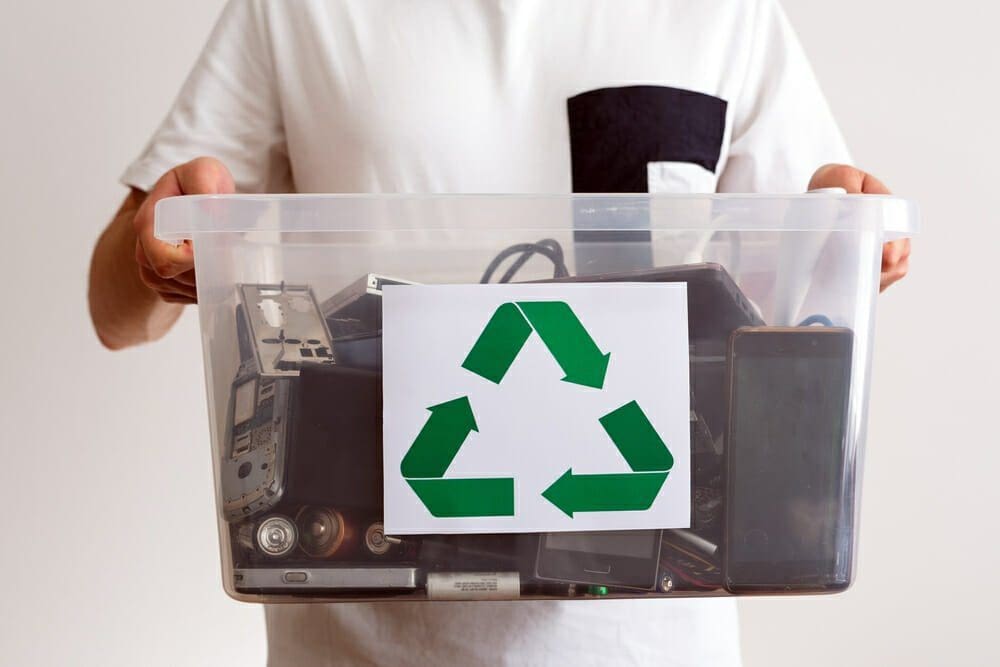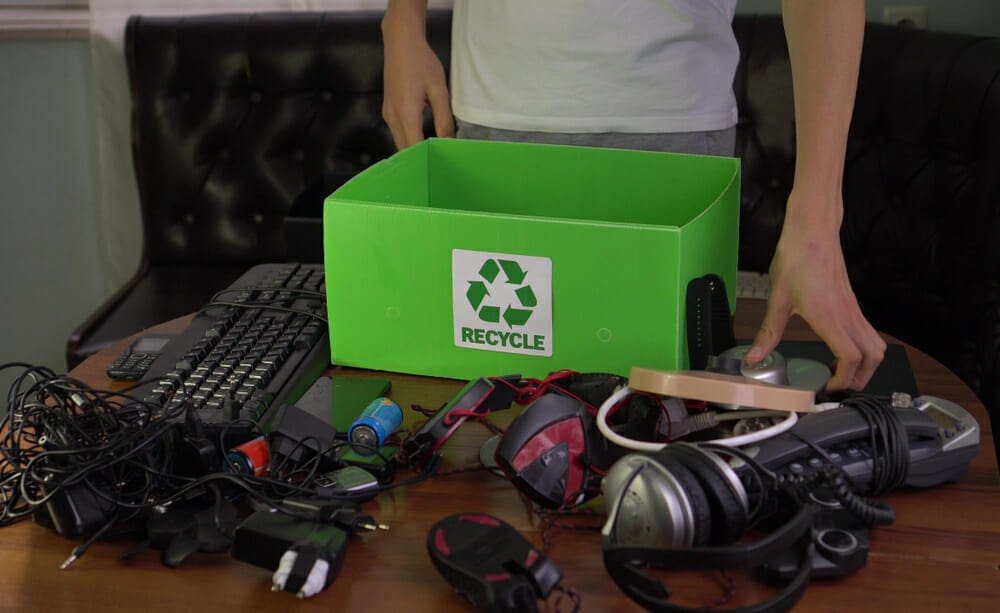Electronic waste, often called e-waste, is a growing environmental concern in today’s digital age. With the rapid advancement of technology, the lifespan of electronic devices is decreasing, leading to a significant increase in e-waste generation. Now, more than ever, it is crucial we all do out part to recycle electronic waste.
Recycling electronic waste is crucial to reduce its environmental impact and conserve valuable resources. This article will explore the best ways to recycle electronic waste and contribute to a more sustainable future.
Table of Contents
Understand the Importance of E-Waste Recycling
Understanding the importance of e-waste recycling is essential in addressing the environmental and societal challenges of the growing accumulation of electronic waste. Here are the key reasons why e-waste recycling matters:

Environmental Protection
E-waste often contains hazardous materials like heavy metals and toxic chemicals. Proper recycling prevents these substances from contaminating the environment, safeguarding ecosystems and human health.
Resource Conservation
Electronic devices contain valuable resources, including precious metals and rare minerals. Recycling e-waste recovers these materials, reducing the need for resource-intensive extraction processes.
Energy Savings
Manufacturing electronics demands significant energy. Recycling reduces the demand for new materials, conserving energy and reducing greenhouse gas emissions.
Sustainable Consumption
E-waste recycling encourages responsible consumer behavior, promoting device longevity and reducing electronic consumption.
Economic Growth
The e-waste recycling industry generates jobs and contributes to economic development, benefiting local communities.
Compliance with Regulations
Recycling e-waste ensures compliance with environmental laws and regulations, avoiding legal consequences for improper disposal.
E-waste recycling is a critical component of sustainable living and environmental stewardship in our digital age.
8 Effective Strategies for Responsible Electronic Waste Recycling
Here are nine of the best ways to recycle electronic waste:
1. Find a Certified E-Waste Recycling Center
One of the most reliable ways to recycle electronic waste is to locate a certified recycling center. These facilities have the expertise and equipment to dismantle and recycle various electronic devices safely.
Look for certifications such as R2 (Responsible Recycling) or e-Stewards, which ensure responsible and environmentally friendly practices.
2. Donate or Reuse Electronic Devices
Before considering recycling, explore opportunities to donate or reuse your electronic devices. If your old smartphone, laptop, or tablet is still functional, it may benefit someone in need. Several organizations and charities accept electronic donations and refurbish them for reuse.
3. Participate in Manufacturer Programs to Recycle Electronic Waste
Many electronics manufacturers offer recycling programs for their products. These programs often allow you to return your old device when purchasing a new one. Manufacturers will then ensure the proper recycling or disposal of the old device, minimizing its environmental impact.
4. Take Advantage of E-Waste Collection Events
Local governments and organizations frequently organize e-waste collection events. These events provide a convenient way for residents to drop off their old electronics for recycling. Check with your local authorities or environmental groups to find out about upcoming collection events in your area.
5. Recycle Batteries Separately
Batteries are a significant component of electronic waste and can be hazardous if not disposed of correctly. Many electronic retailers and recycling centers have separate bins for battery recycling. Ensure that you properly dispose of batteries to prevent chemical leaks and contamination.
6. Securely Erase Data
Before recycling any electronic device that stores personal data, ensure that you securely erase all sensitive information. Use data-wiping software or consult the device’s user manual for instructions. This step helps protect your privacy and prevents the risk of data breaches.
7. Practice Responsible E-Waste Management at Home
Encourage responsible e-waste management within your household by setting up a designated collection area for old electronics. Educate family members about the importance of recycling electronic waste and make it easy for them to participate.
8. Support E-Waste Legislation and Advocacy
Advocate for stronger e-waste recycling laws and regulations in your region. Support initiatives that promote extended producer responsibility (EPR), which encourages electronics manufacturers to take responsibility for the end-of-life management of their products.
How and Where to Responsibly Recycle Old E-Waste?
Recycling old electronic waste (e-waste) responsibly involves the following steps:
Locate Certified Recycling Centers:
Begin by identifying certified e-waste recycling centers in your vicinity. These certified facilities have the expertise and equipment necessary to safely dismantle and recycle electronic devices while ensuring proper disposal of hazardous materials.
Manufacturer Recycling Programs:
Explore recycling programs offered by electronic device manufacturers. Many manufacturers facilitate the return of old devices when purchasing new ones, taking responsibility for their proper recycling or refurbishment.
Participate in Local E-Waste Collection Events:
Keep an eye out for local e-waste collection events organized by local governments or environmental organizations. These events provide convenient drop-off points for old electronics.

Consider Donating to Charitable Organizations:
If your electronic devices are still functional, consider donating them to charitable organizations, schools, or community centers. This not only extends the life of the device but also benefits those in need.
Check Electronic Retailers:
Some electronics retailers operate their recycling programs, particularly for products they sell. Contact your local store to inquire about available recycling options.
Separate Battery Recycling:
Ensure that you recycle batteries separately from other e-waste. Many stores and recycling centers have designated bins for battery disposal, preventing environmental contamination.
By following these steps, you can ensure the responsible recycling of old e-waste, contributing to environmental sustainability and resource conservation.
Bottom Line
In conclusion, responsibly recycling old electronic waste (e-waste) is not only an intelligent choice but vital for our environment, resources, and future generations. By following the outlined steps and utilizing the available resources in your community, you can make a meaningful contribution to reducing the negative impact of e-waste on our planet.
Remember that each responsible recycling action counts, collectively helping us build a more sustainable and eco-conscious world. So, take the initiative, spread awareness, and play your part in safeguarding our environment through responsible e-waste recycling.
Frequently Asked Questions (FAQs)
What Happens To My Old Electronics When I Recycle Them?
Depending on the recycling method, old electronics are typically disassembled and separated into components, with hazardous materials safely disposed of. Valuable materials like metals are recovered for reuse.
Is It Safe To Recycle Electronic Waste At Home?
Recycling e-waste at certified recycling centers equipped to handle hazardous materials is generally safer and more environmentally responsible. Home recycling may not ensure proper disposal of toxins.
What Should I Do To Protect My Data Before Recycling Electronic Devices?
Ensure all personal data is securely erased using data-wiping software or following the manufacturer’s instructions to protect your privacy before recycling or donating devices.
Are There Regulations Governing E-Waste Recycling?
Many regions and countries have implemented regulations and laws to govern e-waste management. These regulations often include requirements for responsible disposal and recycling practices.
